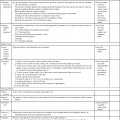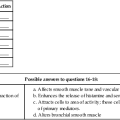At the conclusion of this chapter, the reader should be able to: • Describe important characteristics in the acquisition and development of infectious diseases. • Compare how the body develops immunity to bacterial; parasitic; fungal; and viral, rickettsial, and mycoplasmal diseases. • Briefly describe the laboratory detection of immunologic responses. • Analyze a case study related to the immune response in infectious diseases. • Correctly answer case study related multiple choice questions. • Be prepared to participate in a discussion of critical thinking questions. • Describe the principle and results of the latex Cryptococcus antigen detection system. • The immune status of an individual (Immunocompromised individuals have a much higher rate of microbial disease.) • Overall incidence of an organism in the population • Pathogenicity or virulence of the agent • Presence of a sufficiently large dose of the agent or organism to produce an infection For an infectious disease to develop in a host, the organism must penetrate the skin or mucous membrane barrier (first line of defense) and survive other natural and adaptive body defense mechanisms (see Chapter 1). These mechanisms include phagocytosis, antibody and cell-mediated immunity or complement activation, and associated interacting effector mechanisms. Phagocytosis and complement activation may be initiated within minutes of invasion by a microorganism; however, unless primed by previous contact with the same or similar antigen, antibody and cell-mediated responses do not become activated for several days. Complement and antibodies are the most active constituents against microorganisms free in the blood or tissues, whereas cell-mediated responses are most active against microorganisms associated with cells. Parasites are relatively large, may have resistant body walls, and may avoid being phagocytized because of their ability to migrate away from an inflamed area. These differences set parasitic infections apart from bacterial and viral infections to which some forms of natural and adaptive immunity afford protection. (Toxoplasmosis, a representative disease, is discussed in Chapter 20.) Immune responses (effectors) to parasitic infections include immunoglobulins, complement, antibody-dependent, cell-mediated cytotoxicity, and cellular defenses such as eosinophils and T cells. Some cestodes, especially in their larval stages, may be eradicated by complement-fixing immunoglobulin G (IgG) antibodies. In addition, some antibodies may cross-react with other parasitic antigens. Increased levels of IgE may be noted in many helminth infections. Activation of the classic and alternate complement pathways may occur in some cases of schistosomiasis, and the alternate pathway of complement activation may kill larvae in the absence of antibody (see Chapter 5). Fungal infections are increasing worldwide for a variety of reasons, including the use of immunosuppressive drugs and the development of diseases that result in an immunocompromised host (e.g., acquired immune deficiency syndrome [AIDS]). Serologic tests often play an important role in the diagnosis of these fungal infections (Table 15-1). Table 15-1 Testing Methods for Fungal Disease EIA, Enzyme immunoassay; CSF, cerebrospinal fluid; PCR, polymerase chain reaction.
The Immune Response in Infectious Diseases
Characteristics of Infectious Diseases
Development of Infectious Diseases
Parasitic Diseases
Fungal Diseases
Disease
Procedure
Aspergillosis
Gel immunodiffusion, EIA; IgG to Aspergillus fumigatus (≤110 mg/L), 85% of farmers and some persons with no evidence of disease
Blastomycosis
Complement fixation (>50% positive in proven cases); immunodiffusion (test is positive in about 80% of cases)
Coccidioidomycosis
Complement fixation using coccidioidin (blood, CSF)
Cryptococcosis
Latex agglutination (serum, CSF), EIA, immunofluorescence assay
Histoplasmosis
Complement fixation, immunodiffusion, PCR (sputum, blood, tissue); Histoplasma capsulatum antigen by EIA (urine); nucleic acid probe
Sporotrichosis
Latex particle agglutination
The Immune Response in Infectious Diseases






